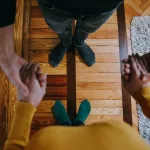With the surge of fitness routines, lacrosse balls have become a staple in many workout spaces. They’re often used incorrectly, though. Unlike tennis balls, lacrosse balls are firm and compact — they don’t compress much under pressure. This makes them an effective tool for self-massage that can reduce discomfort and restore function in achy muscles.
Using a lacrosse ball for massage is a type of self-myofascial release. Fascia is the delicate layer of connective tissue that envelops muscles and organs and connects muscle groups together. When the fascia becomes restricted, it can lead to pain and faulty movement patterns.
Restricted fascia can pull the body out of its proper alignment and increase strain on muscles and joints, producing pain. The aim of myofascial release is to lengthen and loosen the fascia so the tissues underneath can glide and function normally.
What are the advantages of lacrosse ball self-massage?
A review published in the found that self-myofascial release may:
- improve joint range of motion
- support muscle performance
- reduce post-exercise fatigue
- lessen soreness after workouts
Self-myofascial release works best after exercising, but you can perform it anytime during the day when you remember. Sessions only take a few minutes. Like stretching, the greatest benefits come from regular practice.
Try these five self-massage moves to calm sore muscles after your next intense session.
Glutes

Tense or irritated gluteal muscles can produce discomfort in the lower back and hip area. Releasing tension in the buttocks not only feels relieving but also enhances mobility in the hips and spine.
- Stand with your back to a wall and position the lacrosse ball between the wall and the fleshy part of your glutes.
- Shift up and down and side to side until you locate a sensitive spot.
- Lean your weight into the wall, letting the ball press into that area.
- Hold for 30 seconds or until the discomfort eases.
- Repeat on the opposite side.
Hamstrings

Tight hamstrings are common in adults who sit for long periods. This tightness can contribute to pain in the hips, knees, or back and interfere with proper movement mechanics.
- Sit on a firm chair or table high enough so your legs can hang. Put the lacrosse ball beneath your thigh and move it until you find a tender area.
- Lean forward, resting your arm and body weight onto the thigh.
- Slowly straighten and bend your knee for about 30 seconds.
- Shift the ball as needed and repeat the process.
Upper back and shoulders

The trapezius is a broad muscle linking your upper back, neck, and shoulders. It frequently tightens or becomes sore from overuse or stress, which can lead to neck and shoulder discomfort.
- Stand with your back to a wall and wedge a lacrosse ball between the wall and your upper back, placing it to one side of your spine.
- Move in all directions until you discover a tender area.
- Sink your weight into the wall and cross your arms over your chest.
- Continue moving slowly up and down, working out any knots or sore spots you encounter.
- Repeat on the opposite side.
Chest and shoulders

Tightness in the chest muscles can worsen posture and cause neck and back pain. Releasing chest tightness with a lacrosse ball can improve posture and increase mobility.
- Stand facing the edge of a wall or a doorway.
- Place the lacrosse ball on your chest muscle near the armpit.
- Lean forward past the wall’s edge and slowly roll the ball over the chest and shoulder area.
- When you find a tender point, relax into that position. You can slide your arm up and down the wall for additional benefit. Move in small circles to gently work the area.
- Repeat on the other side.
Feet (plantar fascia)

Plantar fasciitis results in pain along the underside of the foot. It’s caused by inflammation or irritation of the plantar fascia, a thick band of tissue along the sole. Myofascial release can help break down adhesions and reduce discomfort.
- Sit comfortably with your feet flat on the floor.
- Put the lacrosse ball under the arch of your foot.
- Lean forward, shifting weight onto the affected foot, and slowly roll the ball back and forth along the arch.
- Continue for 30 to 60 seconds.
- Repeat on the other foot if needed.
Next steps
If you can handle the brief discomfort, lacrosse ball self-massage is an excellent technique to release tightness. It helps break up adhesions between the fascia and the muscles beneath. Use these methods daily on areas that trouble you, especially after a hard workout. Consistent self-myofascial release can not only make you feel better but also enhance performance and speed recovery.


















Leave a Reply
You must be logged in to post a comment.